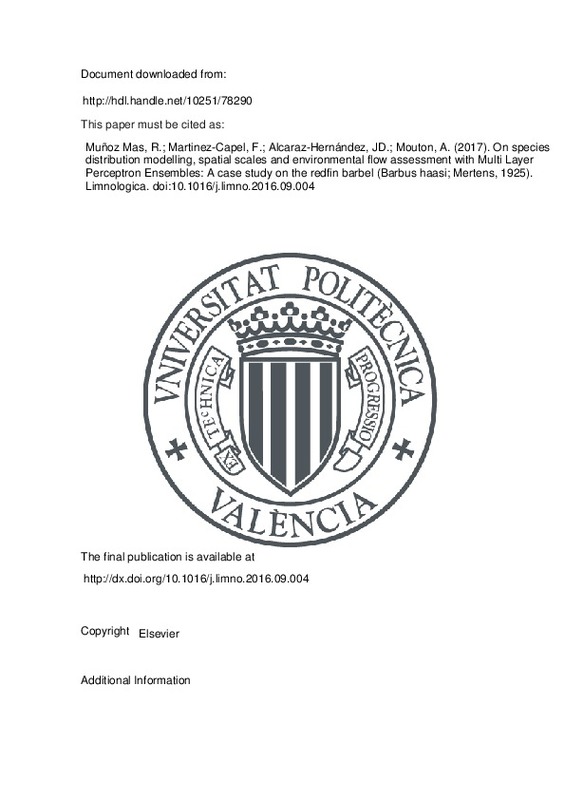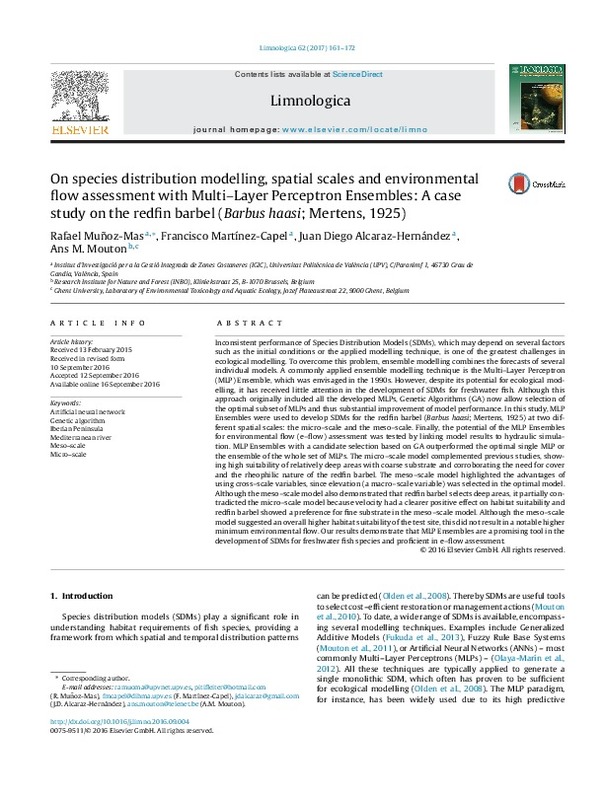JavaScript is disabled for your browser. Some features of this site may not work without it.
Buscar en RiuNet
Listar
Mi cuenta
Estadísticas
Ayuda RiuNet
Admin. UPV
On species distribution modelling, spatial scales and environmental flow assessment with Multi Layer Perceptron Ensembles: A case study on the redfin barbel (Barbus haasi; Mertens, 1925)
Mostrar el registro sencillo del ítem
Ficheros en el ítem
| dc.contributor.author | Muñoz Mas, Rafael
|
es_ES |
| dc.contributor.author | Martinez-Capel, Francisco
|
es_ES |
| dc.contributor.author | Alcaraz-Hernández, Juan Diego
|
es_ES |
| dc.contributor.author | Mouton, Ans
|
es_ES |
| dc.date.accessioned | 2017-02-24T15:19:16Z | |
| dc.date.available | 2017-02-24T15:19:16Z | |
| dc.date.issued | 2017-01 | |
| dc.identifier.issn | 0075-9511 | |
| dc.identifier.uri | http://hdl.handle.net/10251/78290 | |
| dc.description.abstract | Inconsistent performance of Species Distribution Models (SDMs), which may depend on several factors such as the initial conditions or the applied modelling technique, is one of the greatest challenges in ecological modelling. To overcome this problem, ensemble modelling combines the forecasts of several individual models. A commonly applied ensemble modelling technique is the Multi Layer Perceptron (MLP) Ensemble, which was envisaged in the 1990s. However, despite its potential for ecological modelling, it has received little attention in the development of SDMs for freshwater fish. Although this approach originally included all the developed MLPs, Genetic Algorithms (GA) now allow selection of the optimal subset of MLPs and thus substantial improvement of model performance. In this study, MLP Ensembles were used to develop SDMs for the redfin barbel (Barbus haasi; Mertens, 1925) at two different spatial scales: the micro scale and the meso scale. Finally, the potential of the MLP Ensembles for environmental flow (e flow) assessment was tested by linking model results to hydraulic simulation. MLP Ensembles with a candidate selection based on GA outperformed the optimal single MLP or the ensemble of the whole set of MLPs. The micro scale model complemented previous studies, showing high suitability of relatively deep areas with coarse substrate and corroborating the need for cover and the rheophilic nature of the redfin barbel. The meso scale model highlighted the advantages of using cross scale variables, since elevation (a macro scale variable) was selected in the optimal model. Although the meso scale model also demonstrated that redfin barbel selects deep areas, it partially contradicted the micro scale model because velocity had a clearer positive effect on habitat suitability and redfin barbel showed a preference for fine substrate in the meso scale model. Although the meso scale model suggested an overall higher habitat suitability of the test site, this did not result in a notable higher minimum environmental flow. Our results demonstrate that MLP Ensembles are a promising tool in the development of SDMs for freshwater fish species and proficient in e flow assessment. | es_ES |
| dc.description.sponsorship | This study was funded by the Spanish Ministry of Economy and Competitiveness with the projects SCARCE (Consolider-Ingenio 2010 CSD2009-00065). We thank to Confederacion Hidrografica del Jucar (Spanish Ministry of Agriculture, Food and Environment), especially to the Office for Water Planning and Teodoro Estrela for the data provided to develop the SDMs. Finally we would like to thank TECNOMA S.A. for the development of the hydraulic model in the Mijares River and all the people who participated in the field data collection. | en_EN |
| dc.language | Inglés | es_ES |
| dc.publisher | Elsevier | es_ES |
| dc.relation.ispartof | Limnologica | es_ES |
| dc.rights | Reserva de todos los derechos | es_ES |
| dc.subject | Artificial neural network | es_ES |
| dc.subject | Genetic algorithm | es_ES |
| dc.subject | Iberian Peninsula | es_ES |
| dc.subject | Mediterranean river | es_ES |
| dc.subject | Meso scale | es_ES |
| dc.subject | Micro scale | es_ES |
| dc.subject.classification | TECNOLOGIA DEL MEDIO AMBIENTE | es_ES |
| dc.title | On species distribution modelling, spatial scales and environmental flow assessment with Multi Layer Perceptron Ensembles: A case study on the redfin barbel (Barbus haasi; Mertens, 1925) | es_ES |
| dc.type | Artículo | es_ES |
| dc.identifier.doi | 10.1016/j.limno.2016.09.004 | |
| dc.relation.projectID | info:eu-repo/grantAgreement/MICINN//CSD2009-00065/ES/Evaluación y predicción de los efectos del cambio global en la cantidad y la calidad del agua en ríos ibéricos/ | es_ES |
| dc.rights.accessRights | Abierto | es_ES |
| dc.date.embargoEndDate | 2019-01-31 | es_ES |
| dc.contributor.affiliation | Universitat Politècnica de València. Instituto de Investigación para la Gestión Integral de Zonas Costeras - Institut d'Investigació per a la Gestió Integral de Zones Costaneres | es_ES |
| dc.contributor.affiliation | Universitat Politècnica de València. Escuela Politécnica Superior de Gandia - Escola Politècnica Superior de Gandia | es_ES |
| dc.description.bibliographicCitation | Muñoz Mas, R.; Martinez-Capel, F.; Alcaraz-Hernández, JD.; Mouton, A. (2017). On species distribution modelling, spatial scales and environmental flow assessment with Multi Layer Perceptron Ensembles: A case study on the redfin barbel (Barbus haasi; Mertens, 1925). Limnologica. 62. https://doi.org/10.1016/j.limno.2016.09.004 | es_ES |
| dc.description.accrualMethod | S | es_ES |
| dc.relation.publisherversion | http://dx.doi.org/10.1016/j.limno.2016.09.004 | es_ES |
| dc.type.version | info:eu-repo/semantics/publishedVersion | es_ES |
| dc.description.volume | 62 | |
| dc.relation.senia | 322136 | es_ES |
| dc.contributor.funder | Ministerio de Ciencia e Innovación | es_ES |









